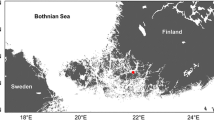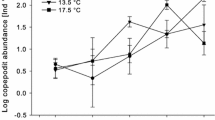Abstract
In coastal ecosystems with decades of eutrophication and other anthropogenic stressors, the impact of climate change on planktonic communities can be difficult to detect. A time series of monthly water temperatures in the Central Basin of Long Island Sound (LIS) from the late 1940s until 2012 indicates a warming rate of 0.03 °C year−1. Relative to the early 1950s, there has been a concurrent decrease in the mean size of the dominant copepod species Acartia tonsa and Acartia hudsonica, an increase in the proportion of the small copepod Oithona sp., and the disappearance of the two largest-sized copepod genera from the 1950s. These changes are consistent with predictions of the impact of climate change on aquatic ectotherms. This suggests that even in eutrophic systems where food is not limiting, a continued increase in temperature could result in a smaller-sized copepod community. Since copepods dominate the zooplankton, which in turn link primary producers and upper trophic levels, a reduction in mean size could alter food web connectivity, decreasing the efficiency of trophic transfer between phytoplankton and endemic larval fish.




Similar content being viewed by others
References
Balazs, G.H., and M. Chaloupka. 2004. Thirty-year recovery trend in the once depleted Hawaiian green sea turtle stock. Biological Conservation 117: 491–498.
Beaugrand, G., F. Ibañez, J.A. Lindley, and P.C. Reid. 2002. Diversity of calanoid copepods in the North Atlantic and adjacent seas: species associations and biogeography. Marine Ecological Progress Series 232: 179–195.
Boyce, D.G., M.R. Lewis, and B. Worm. 2010. Global phytoplankton decline over the past century. Nature 466: 591–596.
Bundy, A. 2001. Fishing on ecosystems: the interplay of fishing and predation in Newfoundland-Labrador. Canadian Journal of Fisheries and Aquatic Science 58: 1153–1167.
Capriulo, G.M., G. Smith, R. Troy, G.H. Wikfors, J. Pellet, and C. Yarish. 2002. The planktonic food web structure of a temperate zone estuary, and its alteration due to eutrophication. Hydrobiologia 475(476): 263–333.
Checkley Jr., D.M. 1982. Selective feeding by Atlantic herring (Clupea harengus) larvae on zooplankton in natural assemblages. Marine Ecology Progress Series 9: 245–253.
Chen, B., M.R. Landry, B. Huang, and H. Liu. 2012. Does warming enhance the effect of microzooplankton grazing on marine phytoplankton in the ocean? Limnology and Oceanography 57: 519–526.
Conover, R.J. 1956. Biology of Acartia clausi and A. tonsa. Bulletin of The Bingham Oceanographic Collection 15: 156–233.
Dam, H.G. 2013. Evolutionary adaptation of marine zooplankton to global change. Annual Review of Marine Sciences 5: 349–370.
Dam, H.G., and W.T. Peterson. 1991. In situ feeding behavior of the copepod Temora longicornis: effects of seasonal variations of chlorophyll size fractions and female body size. Marine Ecology Progress Series 71: 113–123.
Dam, H.G., W.T. Peterson, and D.C. Bellantoni. 1994. Seasonal feeding and fecundity of the calanoid copepod Acartia tonsa in Long Island Sound: is omnivory important to egg production? Hydrobiologia 292(293): 191–199.
Dam, H.G., M.R. Roman, and M.J. Youngbluth. 1995. Downward export of respiratory carbon and dissolved organic nitrogen by diel migrant mesozooplankton at the JGOFS Bermuda timeseries station. Deep-Sea Research I 42: 1187–1197.
Dam, H.G., and G.B. McManus. 2009. Monitoring mesozooplankton and microzooplankton in Long Island Sound, national coastal assessment. Final report to CT DEP Bureau of Water Management.
Danovaro, R., A. Dell‘Anno, and A. Pusceddu. 2004. Biodiversity response to climate change in a warm deep sea. Ecology Letters 7: 821–828.
Daufresne, M., K. Lengfellner, and U. Sommer. 2009. Global warming benefits the small in aquatic ecosystems. Proceedings of the National Academy of Sciences 106: 12788–12793.
Deevey, G.B. 1956. Oceanography of Long Island Sound, 1952–1954. V. Zooplankton. Bulletin of The Bingham Oceanographic Collection 15: 113–155.
Deevey, G.B. 1960. Relative effects of temperature and food on seasonal variations in length of marine copepods in some eastern American and western European waters. Bulletin of The Bingham Oceanographic Collection 17: 54–85.
Durbin, E.G., A.G. Durbin, T.J. Smayda, and P.G. Verity. 1983. Food limitation of production by adult Acartia tonsa in Narragansett Bay, Rhode Island. Limnology and Oceanography 28(6): 1199–1213.
Durbin, E.G., A.G. Durbin, and R.G. Campbell. 1992. Body size and egg production in the marine copepod Acartia hudsonica during a winter–spring diatom bloom in Narragansett Bay. Limnology and Oceanography 37(2): 342–360.
Evans, F. 1981. An investigation into the relationship of sea temperature and food supply to the size of the planktonic copepod Temora longicornis Müller in the North Sea. Estuarine, Coastal and Shelf Science 13: 145–158.
Forster, J., and A. Hirst. 2012. The temperature–size rule emerges from ontogenetic differences between growth and development rates. Functional Ecology 26: 483–492.
Forster, J., A.G. Hirst, and D. Atkinson. 2012. Warming-induced reductions in body size are greater in aquatic than terrestrial species. Proceedings of the National Academy of Sciences 109: 19310–19314.
Harris, R.P., P.H. Wiebe, J. Lenz, H.R. Skjoldal, and M. Huntley. 2000. ICES zooplankton methodology manual. London: Academic.
Hopcroft, R.R., J.C. Roff, and F.P. Chavez. 2001. Size paradigms in copepod communities: a re-examination. Hydrobiologia 453(454): 133–141.
Howell, P., and P.J. Auster. 2012. Phase shift in an estuarine finfish community associated with warming temperatures. Marine and Coastal Fisheries: Dynamics, Management, and Ecosystem Science 4: 481–495.
Huntley, M.E., and M.D.G. Lopez. 1992. Temperature-dependent production of marine copepods: a global synthesis. The American Naturalist 140: 201–242.
Johnson, W.S., and D.M. Allen. 2005. Zooplankton of the Atlantic and Gulf Coasts: a guide to their identification and ecology. Baltimore: Johns Hopkins University Press.
Kane, J. 2003. Spatial and temporal abundance patterns for the late stage copepodites of Metridia lucens (Copepoda: Calanoida) in the US northeast continental shelf ecosystem. Journal of Plankton Research 25: 151–167.
Kimmel, D.G., M.R. Roman, and X. Zhang. 2006. Spatial and temporal variability in factors affecting mesozooplankton dynamics in Chesapeake Bay: evidence from biomass size spectra. Limnology and Oceanography 51: 131–141.
Lonsdale, D.J., E.M. Cosper, W.S. Kim, M. Doall, A. Divadeenam, and S.H. Jonasdottir. 1996. Food web interactions in the plankton of Long Island bays, with preliminary observations on brown tide effects. Marine Ecology Progress Series 134: 247–263.
Moore, M., and C. Folt. 1993. Zooplankton body size and community structure: effects of thermal and toxicant stress. Trends in Ecology and Evolution 8: 175–183.
Nakamura, Y., and J. Turner. 1997. Predation and respiration by the small cyclopoid copepod Oithona similis: how important is feeding on ciliates and heterotrophic flagellates? Journal of Plankton Research 19: 1275–1288.
Nixon, S.W., S. Granger, B. Buckley, M. Lamont, and B. Rowell. 2004. A one hundred and seventeen year coastal water temperature record from Woods Hole, MA. Estuaries and Coasts 27: 1–8.
Park, G.S., and H.G. Marshall. 2000. Estuarine relationships between zooplankton community structure and trophic gradients. Journal of Plankton Research 22: 121–135.
Pelletier, M.C., A.J. Gold, L. Gonzalez, and C. Oviatt. 2012. Application of multiple index development approaches to benthic invertebrate data from the Virginian Biogeographic Province, USA. Ecological Indicators 23: 176–188.
Peterson, W.T. 1985. Abundance, age structure, and in-situ egg production rates of the copepod Temora longicornis in Long Island Sound, New York. Bulletin of Marine Science 37: 726–738.
Pinto-Coelho, R.M. 1998. Effects of eutrophication on seasonal patterns of mesozooplankton in a tropical reservoir: a 4-year study in Pampulha Lake, Brazil. Freshwater Biology 40: 159–173.
Põllupüü, M. 2007. Effect of formalin preservation on the body length of copepods. Proceeding of the Estonian Academy of Science, Biology, and Ecology 56: 326–331.
Rice, E.J., and G.M. Stewart. 2013. Analysis of interdecadal trends in chlorophyll and temperature in the Central Basin of Long Island Sound. Estuarine, Coastal and Shelf Science 128: 65–75.
Riley, G.A., S.A.M. Conover, G.B. Deevey, R.J. Conover, S.B. Wheatland, E. Harris, and H.L. Sanders. 1956. Oceanography of Long Island Sound, 1952–1954. Bulletin of The Bingham Oceanographic Collection 15: 1–414.
Riley, G.A., and S.A.M. Conover. 1956. Chemical oceanography of Long Island Sound, 1952–1954. Bulletin of The Bingham Oceanographic Collection 15: 47–61.
Sabatini, M.E. 1990. The developmental stages (Copepodids I to VI) of Acartia tonsa danae, 1849 (Copepoda, Calanoida). Crustaceana 59: 53–56.
Seekall, D.A., and M.L. Pace. 2011. Climate change drives warming in the Hudson River Estuary, New York (USA). Journal of Environmental Monitoring 13: 2321–2327.
Sen, P.K. 1968. Estimates of the regression coefficient based on Kendall’s tau. Journal of the American Statistical Association 63: 1379–1389.
Sheridan, J.A., and D. Bickford. 2011. Shrinking body size as an ecological response to climate change. Nature Climate Change 1: 401–406.
Stachowicz, J.J., J.R. Terwin, R.B. Whitlatch, and R.W. Osman. 2002. Linking climate change and biological invasions: ocean warming facilitates nonindigenous species invasions. Proceedings of the National Academy of the Sciences 99: 15497–15500.
Turner, J.T. 1984. The feeding ecology of some zooplankters that are important prey items of larval fish. NOAA Tech Rep National Marine Fisheries Service 7: 1–28.
Uye, S.I., T. Shimazu, M. Yamamuro, Y. Ishitobi, and H. Kamiya. 2000. Geographical and seasonal variations in mesozooplankton abundance and biomass in relation to environmental parameters in Lake Shiji–Ohashi River–Lake Nakaumi brackish-water system, Japan. Journal of Marine Systems 26: 193–207.
Viitasalo, M., M. Koski, K. Pellikka, and S. Johansson. 1995. Seasonal and long-term variations in the body size of planktonic copepods in the northern Baltic Sea. Marine Biology 123: 241–250.
Wickstead, J.H. 1976. Marine zooplankton. Studies in biology no. 62. London: Edward Arnold.
Acknowledgments
We thank the NMFS/NOAA Milford Laboratory for providing the temperature data. We thank Matthew Lyman and Katie O’Brien-Clayton of the CTDEEP for their assistance in collecting zooplankton samples. We thank the captains of the R/V John Dempsey and R/V Patricia Lynn, Rodney Randall and Kurt Gotschall, as well as the captain of R/V Victor Loosanoff, Robert Alix, and his crewmate, Werner Schreiner. For assistance with statistical analysis, Professor Jeff Bird of Queens College and Professor Stephen Baines of SUNY Stony Brook were invaluable. We thank Lydia Norton, University of Connecticut, for the assistance in sizing copepods. Lastly, we would like to thank the thesis committee members of the first author, Professor John Waldman, Professor Greg O’Mullan, Professor John Marra, and especially Dr. Julie Rose, for their patience and insightful comments. Analysis of the zooplankton samples by Dam and McManus and of copepod sizes for the years 2010–2011 was funded by a contract with the CTDEEP.
Author information
Authors and Affiliations
Corresponding author
Additional information
Communicated by Darcy Lonsdale
Rights and permissions
About this article
Cite this article
Rice, E., Dam, H.G. & Stewart, G. Impact of Climate Change on Estuarine Zooplankton: Surface Water Warming in Long Island Sound Is Associated with Changes in Copepod Size and Community Structure. Estuaries and Coasts 38, 13–23 (2015). https://doi.org/10.1007/s12237-014-9770-0
Received:
Revised:
Accepted:
Published:
Issue Date:
DOI: https://doi.org/10.1007/s12237-014-9770-0




